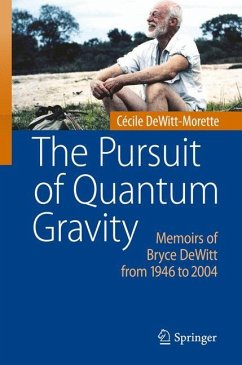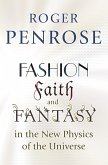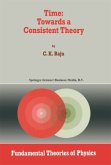1946 is the year Bryce DeWitt entered Harvard graduate school. Quantum Gravity was his goal and remained his goal throughout his lifetime until the very end. The pursuit of Quantum Gravity requires a profound understanding of Quantum Physics and Gravitation Physics. As G. A. Vilkovisky commented , "Quantum Gravity is a combination of two words, and one should know both. Bryce understood this as nobody else, and this wisdom is completely unknown to many authors of the flux of papers that we see nowadays."
Distingished physicist Cecile DeWitt-Morette skillfully blends her personal and scientific account with a wealth of her late husband's often unpublished writings on the subject matter.
This volume, through the perspective of the leading researcher on quantum gravity of his generation, will provide an invaluable source of reference for anyone working in the field.
Distingished physicist Cecile DeWitt-Morette skillfully blends her personal and scientific account with a wealth of her late husband's often unpublished writings on the subject matter.
This volume, through the perspective of the leading researcher on quantum gravity of his generation, will provide an invaluable source of reference for anyone working in the field.
From the reviews:
Bryce DeWitt was one of the intellectual giants of twentieth century physics, a father of the quantum theory of gravity and of numerical relativity (solving Einstein's equations on supercomputers). He was also an adventurer - organizing and leading the last great eclipse expedition, in the desert of Mauritania, to measure Einstein's predicted gravitational deflection of star light, and leader of many wilderness treks.
These wonderful memoirs were produced by DeWitt's partner-in-life-and-science, Cécile Morette (épouse DeWitt). They contain extracts of DeWitt's own writings, many of them gems, embedded in an expository matrix crafted by Morette that makes the gems shine more brightly. We see Morette making the foundations of DeWitt's physics (functional integrals) mathematically reliable, we catch brief glimpses of their life together, but mostly we see DeWitt's seminal ideas and discoveries about the laws of nature, placed in a historical and philosophical context.
Besides compelling pieces aimed at specialists, these memoirs also contain treasures that will delight and inform the more general reader: Why Physics? (a letter from DeWitt to his grandson about the nature of physics and mathematics, and physicists and mathematicians); documents in which DeWitt transforms a wealthy entrepreneur's passion for anti-gravity aircraft into a passion for fundamental physics; the history of the Wheeler-DeWitt equation for the wave function of the universe, with John Wheeler embracing it and DeWitt rejecting it; the history of the Many Worlds (parallel-universes) interpretation of quantum mechanics, with DeWitt embracing it and Wheeler rejecting it; and a carefully crafted letter explaining DeWitt's view of researchers whom the establishment labels "crackpots".
When I picked up this book, I couldn't put it down; I read it cover tocover with enjoyment and delight.
Kip Thorne , The Feynman Professor of Theoretical Physics, California Institute of Technology
I found the book both instructive and fascinating. Bryce DeWitt and Cécile DeWitt-Morette formed the most creative couple in physics that I have ever read about, heard about or, in this case, been privileged to know. Bryce started work on the problem of quantum gravity in the late 1940s, long before it became fashionable, and continued to make trail-blazing contributions until his death. Cécile, superbly trained and gifted in mathematics as well as physics, made many contributions to other fields of physics and also collaborated with Bryce from time to time. Now she has memorialized him in a way that only she could, framing the documented story of his lifelong quest with an account from her unique vantage point. Fortunately, this includes a discussion of functional integration, a field in which her work is of fundamental significance.
John Stachel, Director, Center for Einstein Studies, Boston University
"In The Pursuit of Quantum Gravity ... Cécile DeWitt-Morette offers a personal view of the great man. ... a fascinating collage of essays, letters and commentary that is like a treasure chest ... . the book is enthralling. It made me want to take up the challenge of quantum gravity, to follow the extraordinary trail set down by Bryce and Cécile to that untamed frontier of physics." (Pedro Ferreira, Nature, Vol. 471, March, 2011)
"In The Pursuit of Quantum Gravity: Memoirs of Bryce DeWitt from 1946 to 2004, DeWitt's wife Cécile DeWitt-Morette presents an honest and authoritative account of his remarkable contributions to the quantization and renormalization of the gravitational field and of non-abelian gauge fields, both of which are central today in particle physics. ... contains her well-chosen selection of DeWitt's original writings ... . I heartilyrecommend The Pursuit of Quantum Gravity. Beyond the physics, it delivers a uniquely personal record of what made DeWitt tick." (Leonard Parker, Physics Today, August, 2011)
"This is a wonderful little book. In it Cecile DeWitt-Morette, 'epouse DeWitt', describes her late husband's long journey in pursuit of quantum gravity from the early beginnings in the late 40ies until his death in 2004, with many personal recollections and anecdotes. ... The book will be an inspiration for anyone working in the area of quantum gravity. It may provide common ground at a time when research in quantum gravity is spreading out into an almost babylonic diversity of different and possibly incompatible approaches." (Hermann Nicolai, General Relativity and Gravitation, Vol. 43, 2011)
Bryce DeWitt was one of the intellectual giants of twentieth century physics, a father of the quantum theory of gravity and of numerical relativity (solving Einstein's equations on supercomputers). He was also an adventurer - organizing and leading the last great eclipse expedition, in the desert of Mauritania, to measure Einstein's predicted gravitational deflection of star light, and leader of many wilderness treks.
These wonderful memoirs were produced by DeWitt's partner-in-life-and-science, Cécile Morette (épouse DeWitt). They contain extracts of DeWitt's own writings, many of them gems, embedded in an expository matrix crafted by Morette that makes the gems shine more brightly. We see Morette making the foundations of DeWitt's physics (functional integrals) mathematically reliable, we catch brief glimpses of their life together, but mostly we see DeWitt's seminal ideas and discoveries about the laws of nature, placed in a historical and philosophical context.
Besides compelling pieces aimed at specialists, these memoirs also contain treasures that will delight and inform the more general reader: Why Physics? (a letter from DeWitt to his grandson about the nature of physics and mathematics, and physicists and mathematicians); documents in which DeWitt transforms a wealthy entrepreneur's passion for anti-gravity aircraft into a passion for fundamental physics; the history of the Wheeler-DeWitt equation for the wave function of the universe, with John Wheeler embracing it and DeWitt rejecting it; the history of the Many Worlds (parallel-universes) interpretation of quantum mechanics, with DeWitt embracing it and Wheeler rejecting it; and a carefully crafted letter explaining DeWitt's view of researchers whom the establishment labels "crackpots".
When I picked up this book, I couldn't put it down; I read it cover tocover with enjoyment and delight.
Kip Thorne , The Feynman Professor of Theoretical Physics, California Institute of Technology
I found the book both instructive and fascinating. Bryce DeWitt and Cécile DeWitt-Morette formed the most creative couple in physics that I have ever read about, heard about or, in this case, been privileged to know. Bryce started work on the problem of quantum gravity in the late 1940s, long before it became fashionable, and continued to make trail-blazing contributions until his death. Cécile, superbly trained and gifted in mathematics as well as physics, made many contributions to other fields of physics and also collaborated with Bryce from time to time. Now she has memorialized him in a way that only she could, framing the documented story of his lifelong quest with an account from her unique vantage point. Fortunately, this includes a discussion of functional integration, a field in which her work is of fundamental significance.
John Stachel, Director, Center for Einstein Studies, Boston University
"In The Pursuit of Quantum Gravity ... Cécile DeWitt-Morette offers a personal view of the great man. ... a fascinating collage of essays, letters and commentary that is like a treasure chest ... . the book is enthralling. It made me want to take up the challenge of quantum gravity, to follow the extraordinary trail set down by Bryce and Cécile to that untamed frontier of physics." (Pedro Ferreira, Nature, Vol. 471, March, 2011)
"In The Pursuit of Quantum Gravity: Memoirs of Bryce DeWitt from 1946 to 2004, DeWitt's wife Cécile DeWitt-Morette presents an honest and authoritative account of his remarkable contributions to the quantization and renormalization of the gravitational field and of non-abelian gauge fields, both of which are central today in particle physics. ... contains her well-chosen selection of DeWitt's original writings ... . I heartilyrecommend The Pursuit of Quantum Gravity. Beyond the physics, it delivers a uniquely personal record of what made DeWitt tick." (Leonard Parker, Physics Today, August, 2011)
"This is a wonderful little book. In it Cecile DeWitt-Morette, 'epouse DeWitt', describes her late husband's long journey in pursuit of quantum gravity from the early beginnings in the late 40ies until his death in 2004, with many personal recollections and anecdotes. ... The book will be an inspiration for anyone working in the area of quantum gravity. It may provide common ground at a time when research in quantum gravity is spreading out into an almost babylonic diversity of different and possibly incompatible approaches." (Hermann Nicolai, General Relativity and Gravitation, Vol. 43, 2011)









